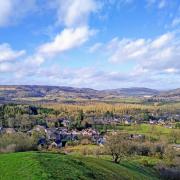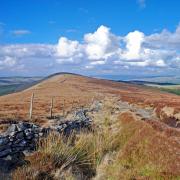At a once busy industrial site in South Derbyshire, common and rare wildlife is thriving. Gemma Bradley takes up the story
Take a moment to imagine the landscape left behind by a former sand and gravel quarry.
Tranquil open waters; reed bed grasses; beavers going about their business; and the occasional rare bird flying overhead might not be the first things that spring to mind.
Yet, nestled away just outside the village of Willington lies Derbyshire Wildlife Trust’s Willington Wetlands Nature Reserve, where a rich wetland habitat has been quietly reclaimed as a haven for wildlife.

Sanctuary in the Wetlands
Prior to being acquired by Derbyshire Wildlife Trust in 2005, gravel was extracted at the site for decades, leaving deep pits across the 114 acres.
Since then, staff and volunteers have helped nature and wildlife take back the landscape by keeping human impact low and encouraging water to flow between the pools left behind.
‘Through careful management, a mosaic of prime wetland habitats has been created, attracting common and rarer plants, birds and animals,’ says Kate Lemon, regional manager for Erewash and Trent Valley at Derbyshire Wildlife Trust.
‘Wetlands offer important sanctuary for many forms of wildlife. The shingle and grass islands provide refuge for ground nesting birds and are ideal for breeding waders. The reed along the edges of the pools provides cover where fish can breed, and insects thrive in the nectar rich grassland.
‘Willington is part of an important ‘wildlife corridor’ that connects other sites across Derbyshire and further afield via the river Trent, all the way to the Humber estuary. It’s an important breeding and re-fuelling stations for resident as well as migratory birds.’
The Rarest Flock
All year round the reserve is rich in bird life, with regular feathered visitors joined by rarer sightings, recorded through supporters sending reports and photos to the Trust-hosted biological record centre.
‘Our extensive area of reed bed are important breeding grounds for reed warbler, sedge warbler and reed bunting,’ Kate continues.
‘Other breeding species include Cetti’s warbler, great-crested grebe, redshank, lapwing, oystercatcher, water rail and occasionally little ringed plover.
‘Our more commonly seen birds include little egret, great white egret, grey heron, snipe, cormorant, and kingfisher.
‘In winter, we see large flocks of wildfowl, including wigeon, teal, pochard and shoveler. As spring approaches, curlew gather on the wet grassland before heading north to their breeding grounds. During spring and autumn, the site becomes home to migratory sand martins, lapwings, and common tern, coming to breed at Willington.
‘Birds of prey are common, including peregrine, kestrel, hobby, and sparrowhawk, and the occasional marsh harrier. This winter, bittern was again seen and, for the first time at Willington, and only the eighth ever recorded in the county, a juvenile purple heron, spotted by birdwatcher Ian Elliott, visited last summer.’
Purple Heron are rare migrants to the UK, with only around 20 records per year. Normally found in southern Europe and some parts of northern Africa, in 2010 a pair bred successfully for the first time in the UK.
Similar in appearance to the more common grey heron, the Purple Heron is slightly smaller, more slender and have a darker plumage with an orange chestnut head, neck and breast, and a purple tinge to their wings.
They are most active at dawn and dusk, preferring to feed in shallow water, where they can easily grab their prey with their powerful beak.

Dam good news for beavers
Willington's wetlands attract several species of colourful dragonfly and damselflies which hunt over the reed bed channels and, in 2021, the site welcomed another new species.
‘Our beaver reintroduction was years in the planning and saw the licensed release of two pairs of beavers in September 2021 - 800 years after they last inhabited the county,’ Kate adds.
‘Often referred to as 'ecosystem engineers', the beavers have been living up to their reputation, making subtle but key changes to the nature reserve, coppicing trees and shrub species, damming smaller ditches, and allowing water to spread by digging 'beaver canal' systems.
‘These activities are helping create a dynamic and evolving wetland which will bring enormous benefits to wildlife including otters, water voles, kingfisher, egret, frogs, toads, dragonflies, and fish, as well as locking up carbon.
‘True to form, the beavers have been busy, and we were delighted to discover one pair had bred, with the first beaver kits sighted in July 2022.’
Next for Willington
The success of the beaver reintroduction, and increase in wildlife, has inspired more visitors and the Trust will make the site more accessible for visitors in the next year.
‘We’re working on an interpretation and access project to improve accessibility to the site,’ says Kate.
‘Over the next few months, we hope to open a new pathway, linking to the Trent and Mersey canal, creating a circular five-mile walk, with improved interpretation and way markers and another raised platform for landscape views.
‘Our original pairs of beavers and the new kits will hopefully continue to thrive and help us shape, improve and care for our wetland area. We look forward to watching these incredible animals continue to transform this habitat, and hope to welcome more kits this summer.
‘This would be good news for the reintroduction of a species, and great for the preservation of an entire ecosystem lost elsewhere in Derbyshire.
‘Our hope is the reserve continues to grow in diversity, welcoming more species as they move through the river valley, and being a hub for wildlife to spread out from.
Information
Visitors are welcome to Willington Wetlands. Much wildlife can be seen all year round, although the beavers are nocturnal and more difficult to spot. There are three viewing platforms and a bird hide, all with posters to help find out more about wildlife.
Parking is available nearby in the village within short walking distance.



























